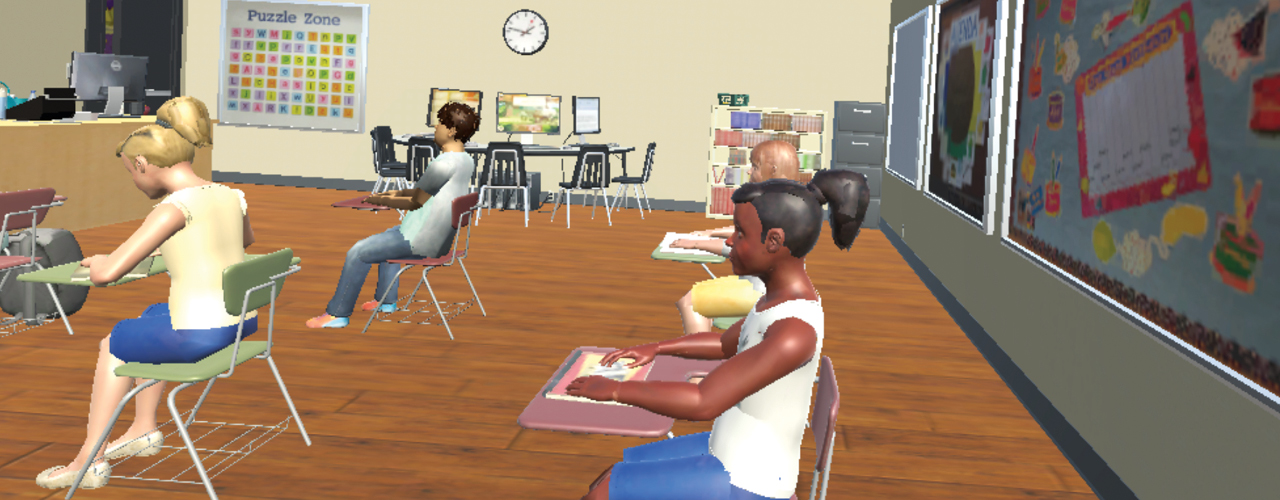Honing in

Can virtual reality help children with ADHD to ignore common classroom distractions?
In the age of texting, social media and pop-up ads, distractions can seem both unavoidable and annoying. But they’re also a growing public health problem, with social harm from distracted driving alone estimated at more than $120 billion each year.
And distraction problems can have especially devastating effects for people with developmental disorders or mental illnesses, from impaired social performance to low graduation rates to increased risk of serious accidents.
UC Davis MIND Institute researcher Julie Schweitzer, Ph.D., is the lead investigator on a new project that aims to use virtual reality to improve our understanding of this distractibility and develop targeted treatments for it. Backed by an initial $1 million from the National Institutes of Health, Schweitzer and colleagues are testing a new form of treatment that uses the “VR” technology to deliver proven exposure therapy and habituation learning techniques to highly distractible children.
Initial pilot studies will center on kids with attention deficit hyperactivity disorder, due both to their high susceptibility to interruptions and also a larger social urgency to find new therapies. If the treatment proves successful, Schweitzer hopes that such “virtual reality attention management systems” will also prove helpful for others with impairing distractibility, such as kids with autism and teen drivers.
“Our long-term goal is to develop interventions that are widely accessible,” says Schweitzer, a psychiatry professor who directs the MIND Institute’s ADHD and Attention, Impulsivity, Regulation (AIR) program. “If a parent could download an app to purchase the treatment, families in many places around the world could access it.
“VR headsets are widely available and dropping in price — there’s even a cardboard version that’s really inexpensive.”
In the pilot study under recruitment at UC Davis, 50 children will be asked to perform attention-demanding tasks in a virtual classroom environment with a high rate of distractors, such as peers talking or teachers walking by. The 25-minute daily sessions can be completed on a VR headset at home, with intensity and rate of distractions adapted according to performance. The underlying neural targets are proactive and reactive control mechanisms used to suppress distractor processing, but investigators also suspect the prefrontal cortex, intraparietal sulcus, visual and auditory cortex will be involved.
The project was born out of a confluence of ideas, Schweitzer said, including anecdotes from ADHD parents and research by study colleagues on VR as a tool for assessing ADHD and delivering exposure therapy for anxiety disorders.
Parents are increasingly interested in non-pharmaceutical treatments for ADHD, especially in California. Almost 70 percent of school-age children with the condition take stimulants or other medications, whose side effects can include problems with sleep and appetite.
If Schweitzer’s initial pilot testing is successful, the NIH is expected to award up to $2 million more for a larger-scale pilot. A confirmatory clinical trial involving hundreds of subjects would follow. Future studies could also include alternate VR scenarios, such as a homework setting or social situation, and extend to distraction-laden adult workplace situations.
“I’ve actually spoken with a number of emergency medicine physicians who would like to learn how to ignore distractions more in their intense environments,” Schweitzer said. “They might be better trained with ‘augmented’ reality than virtual reality, but you’d have a similar strategy.”
Collaborators include Barbara Rothbaum of Emory University and Albert “Skip” Rizzo of USC, as well as UC Davis researchers Peter Mundy, Joy Geng, Prerona Mukherjee, Ana-Maria Iosif, J. Faye Dixon and Catherine Fassbender.



